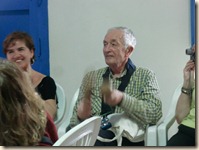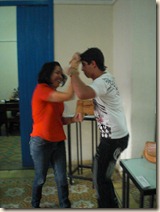The next stop we make is in Santa Clara proper – where we get to visit a guitar “factory”. As Osmel is parking the bus, we happen to look down on the street and see this car. OMG! They have really good mechanics here, but we don’t think this car has seen one lately – the wires on they steering wheel! It’s astonishing this thing hasn’t caught fire yet!
We exit the bus and start to walk through the narrow streets, when it starts to sprinkle, then it starts to rain harder and we are really almost sprinting (well, as fast as some of these folks can sprint!) to the guitar community project. Once inside, we are in a little anteroom, and we see that originally the display was to be outside. Probably not going to happen. So they bring the chairs inside, wipe them off and manage to squeeze us all in this little room while we listen to the presentation on the “Tres” – a special guitar only made in Cuba.
Originally, a similar guitar was brought from Spain in the 18th Century. The indigenous Indians had drums, but now there was this guitar type object for additional harmony. The origin of the Tres can be traced to the Eastern end of Cuba, probably originating in Santiago de Cuba where there is a large port. It is a combination of a Lute and a 3 string instrument. It is smaller than a traditional guitar, asymmetrical in shape with 3 sets of two strings. These guitars were only used by local people, the talent handed down through families. Now, however, the Tres is taught in schools.
Olinde is the owner of this project, and he and his son Tony make the guitars. They are composed of different types of wood for different parts of the Tres and hand cut and formed. It takes 3 to 4 weeks to make 1 Tres and they sell for abut 300 CUCs each. Olinde gives us a great presentation, showing us the guitar, how it’s played and how it it is made by heating the wood and pressing it along the form.

Alan (1/2 of the couple we call “The Boys”) plays the mariachis while Maggi dances.
And Julie also gets into the swing of things. Tony (the guitar maker’s son) has had his eye on Julie since he walked in the door – now it’s his turn to make the moves….(sorry, blurry, darn camera….what can I say?)
At the end of the presentation, we are given adorable little wooden keychains in the shapes of instruments. So sweet! And there’s a little craft type market in the side room with carved items, etc. I end up getting a really cool little wooden notepad with the Cuban flag and palm trees on it while Ed gets the band’s CD.
On the long ride back, Julie asks us questions this time, like what did we like best, what did we like least (Robert of course says Las Brisas!), would we recommend our friends come here to visit, what was unexpected (no armed guards – of course, right as that is said, we pass a military guy with a gun!). Julie also tells us more odd facts about Cuba:
- You cannot kill a cow. Only the government can kill cows.
- If you own cattle, it must only be used for dairy products. If a cow dies, the government will come out and investigate and you will be punished if they find out you killed the cow.
- Only government owned cattle farms are used for the beef served in the restaurants.
- Fidel once had an idea that the cows would produce more/taste better if their brains were cooler. So, they started to develop a plan where they would build these air conditioned sheds for the cows to stick their heads in. Didn’t go very far….but he has all sorts of ideas like that – some obviously better than others!
Fun way to spend the ride back to Habana after a very nice day!









No comments:
Post a Comment